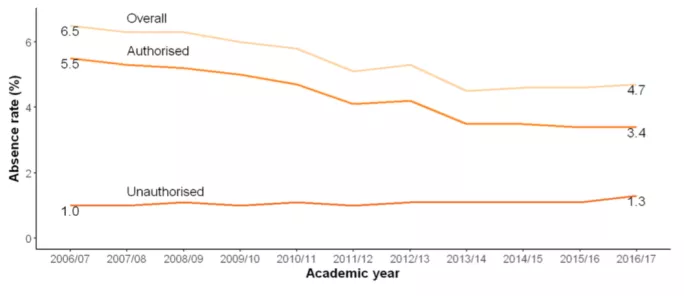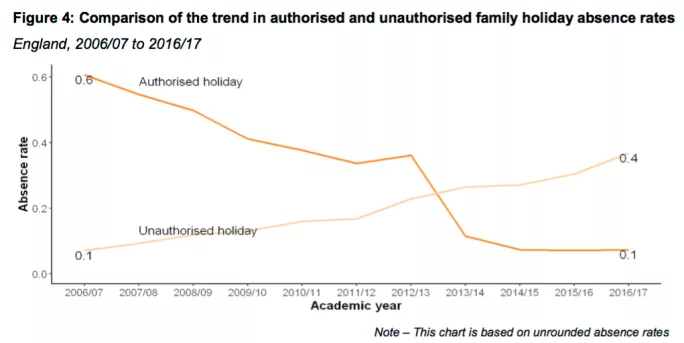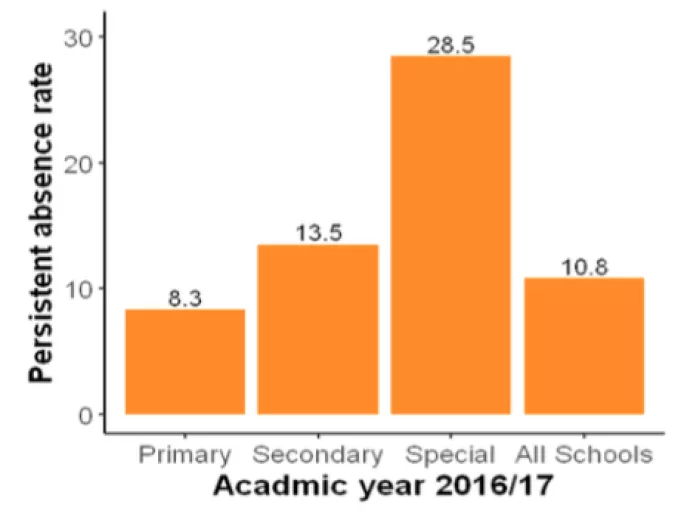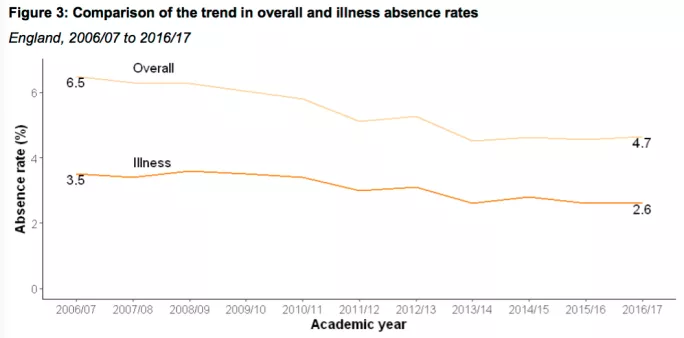The government has published new statistics on pupil absences that show an increasing absence rate, but fewer fines being issued for non-attendance.
Here are some of the key points:
1. Absence rates rose last year
The overall absence rate has increased from 4.6 per cent in 2015-16 to 4.7 per cent in 2016-17. The unauthorised absence rate also rose, from 1.1 per cent to 1.3 per cent during the same period.
But over a longer time period, the historical trend is downwards.
2. Unauthorised holidays drove last year’s increase
The report says the increase in the unauthorised absence rate was “due to higher levels of unauthorised holidays”.
3. Unauthorised term-time holidays continue to rise
Source: DfE
The unauthorised holiday rate has quadrupled since 2006-07. Back then, it stood at 0.1 per cent. Last year, it reached 0.4 per cent.
Significantly, last year’s data covers the period after a High Court ruling, later reversed, supported Isle of Wight parent Jon Platt’s bid to overturn a fine for an unauthorised holiday.
Since 2006-07, the authorised holiday rate has plummeted from 0.6 per cent to 0.1 per cent, with a sharp fall between 2012-13 and 2013-14 explained by a change in DfE rules which said term time leave can only be granted in “exceptional circumstances”.
4. Summer term contains a spike in unauthorised absences
Last year, the unauthorised absence rate was 1.1 per cent in the autumn and spring terms, but jumped to 1.7 per cent in the summer.
5. One in 10 pupils is persistently absent
Source: DfE
This represents another increase on the previous year, with the rate rising from 10.5 per cent to 10.8 per cent. The rate is much higher in special schools than secondaries, and is lowest in primaries.
A child is defined as persistently absent if they miss at least 10 per cent of their possible school sessions.
6. Absence rates are higher for children on free school meals
The overall absence rate for children eligible for and claiming free school meals was 7.3 per cent last year, compared to 4.2 per cent for their peers.
And the persistent absence rate for this group is more than twice that of children not eligible for free school meals.
7. Travellers of Irish heritage have the highest overall absence rate
The rate for this group stood at 18.1 per cent last year, with Gypsy/Roma pupils at 12.9 per cent. This compares to a national average of 4.7 per cent.
At the other end of the spectrum, the rate stood at 2.4 per cent for pupils of a Chinese ethnicity, and 2.9 per cent of a black African ethnicity.
8. Regional variations
The highest overall absence rates are in the North East (4.9 per cent), Yorkshire and the Humber (4.9 per cent) and the South West (4.8 per cent). Inner and outer London had the lowest overall absence rate, at 4.4 per cent.
9. 56.7 million school days were missed because of absences last year
The increase from 54.8 million in the previous year is partly explained by the rising school population, although the average number of days missed per pupil rose slightly from 8.1 to 8.2.
10. Illness is the biggest cause of school absence
Source: DfE
Illness was blamed for more than half of all absences in 2016-17 - 55.3 per cent - although this represents a near-five percentage point drop compared to two years earlier.
Want to keep up with the latest education news and opinion? Follow Tes on Twitter and like Tes on Facebook








